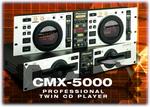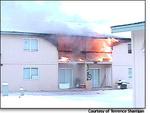Note: This was originally posted Apr. 29th. It’s still up for grabs, so I’m moving the post to today’s date for more visibility.
Asking price: \$300.00 SOLD.
Lightly used, but in excellent condition, this unit was purchased new for \$1300 three years ago, but has sat nearly untouched in the two years since I’ve moved to Seattle and stopped DJing. I can’t say anything but good things about this piece of equipment — it’s one of the best DJ units I’ve had the pleasure to work with.
Unfortunately, all good things must come to an end, as as I’ve hardly touched it in the two years since I’ve been in Seattle, it’s time to see if someone who can get a little more use out of it is interested. I’d prefer if someone in or around Seattle who can swing by and pick it up from me bought it (I’m in the lower First Hill area, close to Downtown), as I don’t have a car and shipping would be a major pain. I can accept cash, checks, or PayPal.
Keep reading for technical details from Pioneer’s site (I’d link directly, but they’ve gone Flash…):
Features:
[![Pioneer CMX-5000]]Auto Mix Play** Armed with an original search system, the CMX-5000 measures a track’s BPM and beat timing and then automatically changes the speed to the designated BPM, thereby realizing smooth mixing even for tracks on a single disc that have different tempos.
Three Playback Methods are Available:
- Track Mode: Performs mixed playback alternating between tracks from discs in both decks.
- Disc Mode: Performs mixed playback of track on a single disc in numerical order.
- Program Mode: Performs mixed playback of tracks in any designated order.
Track Playback Time is Adjustable:
- Short Time Change: Switches the track at a shorter time.
- Instant Change: Switches the track at the DJ’s preferred time.
The Auto mix function is very effective in the following situations:
- At times when there no DJ is present in stores, malls, etc., such as an weekdays nonstop background music can be played in DJ style using the establishment’s favorite selections to help creative a more active atmosphere.
- In bars, restaurants or pubs where the staff work as DJs, the Auto Mix function results in considerable labor saving allowing the staff to devote more of their time to customer service.
- When DJs playing at clubs, etc., need to take a short break to deal with urgent business or emergencies they can use the Auto Mix function to keep the music rolling.
{=html}
– In case of no beat music, smooth mixing cannot be performed because the BPM or beat timing of certain songs can’t be measured correctly.**In the case of tracks on the same disc, cross fading cannot be performed.
***The CMX-5000, while revolutionary with Auto Beat Mixing capability, does have its limitations just like any electronic device. There are certain variables, that if present, will cause the Auto Beat Mixing function to not function properly. A few things must be in order for it to Auto Mix:
- Music must be within a +/-16% ratio. If it is not within this range, not only will it not mix, but the beats will not match as well. The BPM’s will stay the same (even with the BPM sync pressed).
- There must be a steady consistent beat in the beginning of the song. A song that starts with just vocals or off beats rhythms will not mix.
- Any +/-16% range BPM should mix if it is has a CONSISTENT beat.
- You must wait a few seconds for the next song to cue up, before hitting “Instant Change”. The player does have to calculate the beats of the next song. It needs just a few seconds to cue up. You will be know that it ready to go when:
- If the next song programmed is on the other side, an orange colored “dash” going in a semicircle around the display appears.
- If the next song programmed is on the SAME player, the autocue button quits blinking.
The “Instant Change” button must be pressed IN TIME. If you decide to use the “instant change”, it must be done in time for it to automix.
DJ Operating Functions The CMX-5000 incorporates and upgrades the functions of Pioneer’s world-renowned DJ-use CD player — the CDJ 700S/500-II — and also boasts a number of brand new functions.
Clear Jog Dial Although the player is a rack mount component, this design results in a larger jog dial and display which together realize higher operability and easy visual confirmation of the current playback status.
Quick Start This feature permits virtually instantaneous playback with a time lag of less than 0.01 seconds from the pause condition.
Cue Functions (Cue Point/Back Cue/Auto Cue/Cue Paint Sampler) Set your own favorite playback points using the above functions. For example, with Auto Cue, you can set the start point of each track automatically.
Tempo Control The playback speed can be adjusted within three kinds of range. +/- 6/10/16%.
Master Tempo With this feature, you can change the playback speed without altering the music’s pitch.
Loop Functions (Seamless Loop/Realtime Loop/Loop-Out Adjust/Re loop) Uninterrupted sound loops can be easily arranged, and with the Re loop function you can return at any time to a previously set loop.
Playing Address The playing address allows you to check the current track’s playback situation visually in paragraph units.
BPM Counter This counter measures and visually displays the current song’s BPM (Beats Per Minute).
Legato Link Conversion for High Quality Sound Equipped with Pioneer’s original wide-range technology Legato Link Conversion the CMX-5000 is capable of reproducing sound frequencies above 20kHz which are lost during normal CD format playback.
Vibration-Proof Memory and Construction The CMX-5000 boasts excellent vibration-resistant characteristics and prevents sound jumps with the double protection afforded by a maximum 8-second vibration proof memory and a special vibration proof construction.
Slot In Thanks to this system, swapping discs is smooth and rapid, and you can say good-bye to worries about damaging the disc tray.
Mix Out The CMX-5000 incorporates a Mix Out terminal that allows use even in cases where there is only one input system, the setup is restricted to a single amplifier, or there is no mixer input margin.
Multi-Read This function plays back not only CD’s and CD-R’s but also CD-RW discs that are impossible to play on a conventional CD player.
Headphone Monitor This handy monitor function enables versatile sound monitoring.
Digital Output The CMX-5000 is equipped with a digital output terminal.
Fader Start Play/Back Cue Play Using the CMX-5000 together with a Pioneer DJ mixer, you can use the mixer’s fade, to control playback operations such as track start and return to cue point.
[Pioneer CMX-5000]: https://michaelhans.com/eclecticism/2003/04/graphics/cmx5000-2-thumb.jpg {width=”150″ height=”107″}


